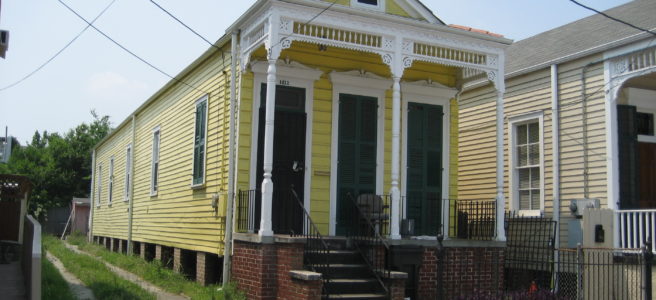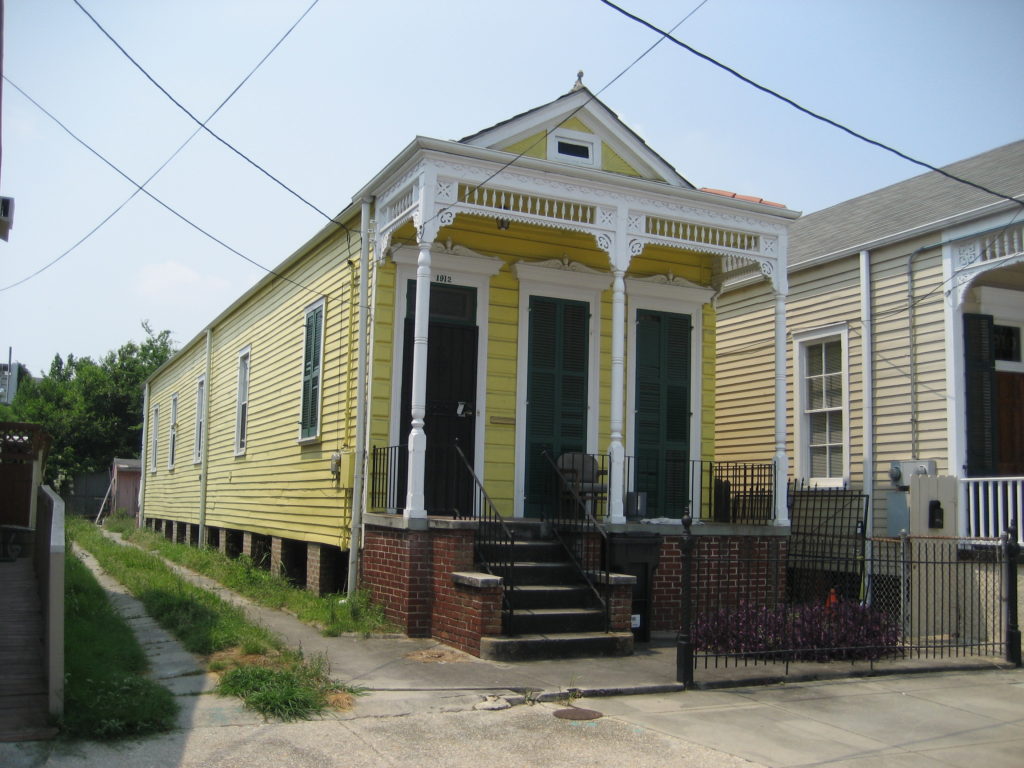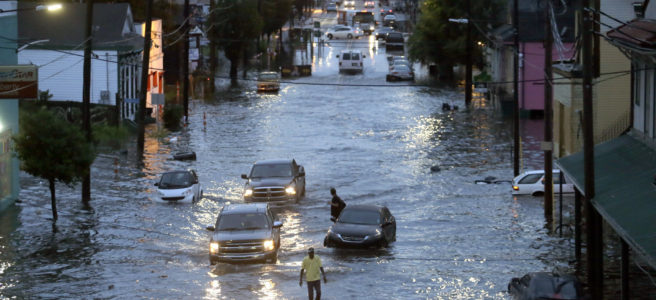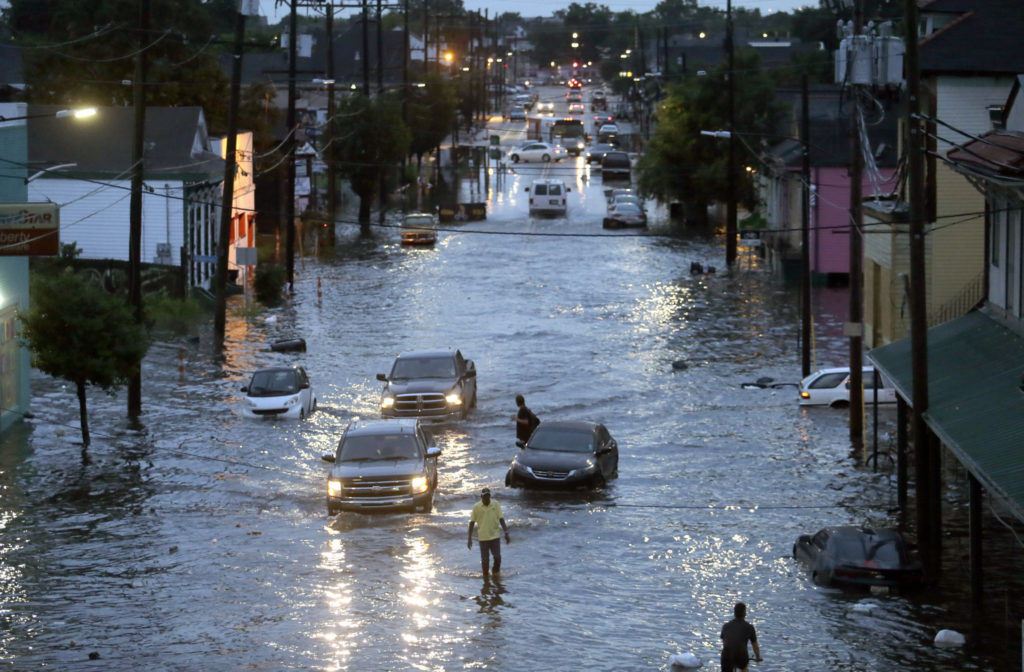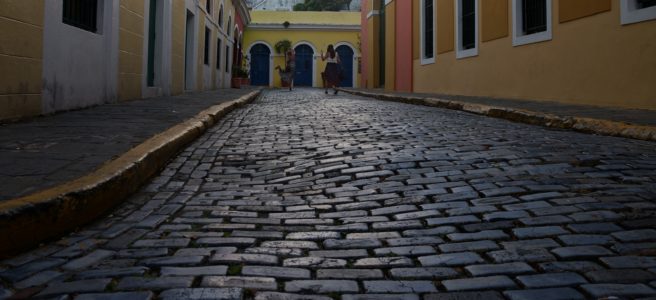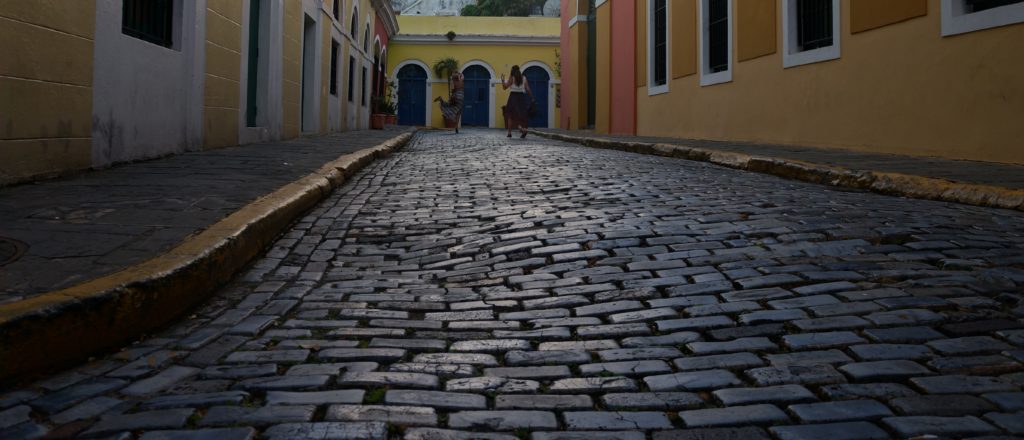We are staying in an early 19th century shotgun house which, for New Orleans, is not an old building – last night we walked past a bar that has been open since 1770 or so – and it seems the shotgun was ahead of its time. There has always been an urban need to store vast quantities of poor people in a small and convenient space, and lacking the resources, the engineering, the geology to pile them into the cinder block prisons of the 20th century housing projects, early New Orleans developers came up with a kind of neatly stacked matchbox dwelling. A shotgun.
A shotgun is a kind of long, narrow row-house that served in this city’s industrial areas as low income housing for immigrants and destitute laborers. Small rooms are partitioned by sliding doors, and narrow floor plans preclude any kind of hallway. Each room is accessed by way of another. This leads the lines between personal and communal space to blur almost immediately, particularly in the high traffic areas adjacent to the front door, the kitchen, the restroom, et cetera.
Our lodging is about twelve feet wide and extends perhaps sixty feet back from the street. Downstairs are three living spaces and a kitchen, where a narrow staircase climbs steeply to two more bedrooms and a small bath.
Tim, Gonzo, and I share a room which is perhaps twelve feet wide and sixteen deep. It has tall, ten or twelve foot ceilings, and is furnished sparsely with a decrepit futon and a wardrobe large enough for three or four jackets. The remains of a fireplace have been mortared over, and gaps between the door and the jamb permit gusts and rain to blow across the hardwood. Tim sleeps on the futon, I on the floor.
This space is separated vaguely from the next room, where mismatched chairs and a battered couch surround a cluttered coffee table. The couch is home to Liza, for whom it is at once a bed and a perch for crafting earrings and Christmas ornaments from stamped steel and brass and plastic beads. As far as I can tell she does not leave her perch for any reason except to use the restroom and, occasionally, to stew beets in the kitchen.
A person accustomed to northern winters may scoff at the notion of being cold in New Orleans, and of course Louisiana is mild during the Christmas season. Temperatures there rarely dip into the 40s and rain showers are calming, maritime affairs. It is a place completely unprepared for winter weather of any kind; if the specter of snow casts a shadow across the weather forecast the city more or less loses its mind. A chance of snow flurries on our third day in the city cancelled schools and drew warnings not to drive except for emergencies.
Even the rich houses are uninsulated, and in our humble shotgun holes in every door and window treatment welcome the outside climate in. This home is not so much as poorly insulated as it is only a meager shelter from the elements at all. A leaking roof has left a jagged scar of cracked and peeling plaster above Liza’s perch, and only a very recent drywall patch keeps the neighborhood pigeons from coming and going from the kitchen as they please.
This is all to say that the cold, rainy weather that joined us in New Orleans chilled me to my core, and that I did not always mind that the gas heater in this middle room runs at full throttle at all hours of the day. The central room is interminably, cloyingly warm. It reeks of incense and designer tobacco. The healthy cigarettes, I am told. Next to our spartan finishings the room feels at once cozy and cramped.
The room serves, aside from Liza’s abode, as what social common space the home can offer. The roommates are the wandering artist type. From Wisconsin or New Jersey or someplace, and work in kitchens or delivering pizzas by bicycle when not chasing gigs. Tim and I keep more or less banker’s hours – staggering bleary-eyed to work some time around 8, making our way home in the evening to recuperate and have a cigarette and mull over where to find dinner for the night. An hour or so before we returned from work, two of the roommates left to deliver pizzas and did not make it home until two or three in the morning.
Another roommate worked, nominally, in a vegan kitchen across town but could never be seen in any kind of cook’s outfit and generally seemed to be occupied beneath the hood of a rusted Jeep for any waking hour. The last girl was only seen once, as she fell during an aerial silks performance and broke her pelvis, and was rushed away someplace else to recover. And so the house never felt overcrowded, and someone always seemed happy to sit and smoke with Liza.
Beyond Liza’s domain, a cloth is draped across a narrow doorway to the kitchen. I cannot report on the kitchen. Since our arrival each horizontal surface there has been adorned by a precariously balanced tower of crusted dishes and scraps of food. The stairway climbs past a slapdash plaster patch intended to finally stunt the pigeons’ foray into the common space. On the second day in the house a rat (or other vermin) chewed a hole in the shower plumbing and the kitchen filled with dripping graywater.
Through the back of the kitchen is a doorway to another bedroom which, I presume, fits the mold of stacked 12’ cubes. I am still unsure of who exactly sleeps in which room, and to whom the other dogs purport to answer. The stairway climbs to a narrow hallway that runs the length of the building and allows the roommates to access the sole restroom without passing through either of the bedrooms upstairs.
I understand that this is not an unusual living situation for the starving artist set in urban Louisiana. It is communal living, forced by architectural circumstance. To reach the restroom, one must slide multiple sets of heavy oak doors and traverse the private lives of his roommates. More than once, Tim tells me, he’s tiptoed past a drunken tryst because he simply couldn’t hold his bladder any longer. It is a lifestyle that is not, perhaps, suitable to everyone.
Our month long tenure in the place has been welcomed with varying levels of enthusiasm. Guy, the patriarch here, welcomed us with open arms; as has Liza, from her perch, and Cory, who I have come to believe occupies the final first floor bedroom. The others seem somewhat less amused, and I suppose I can’t hold them at fault for it. Seven humans and three dogs is quite a lot for a small place.
The place is not without perks, of course. We live six blocks from the Christmas tree lot, four blocks from the restaurants and bars of Magazine Street, and a brief 100 yard shuffle from Parasol’s. It is a dog friendly neighborhood in a dog friendly city, and Gonzo is growing accustomed to joining us at work, at dinner, at the bar. We could use the kitchen if we pleased, and together we pay $350 a month, which for two men and a dog on short notice does not seem unfair.
Like
